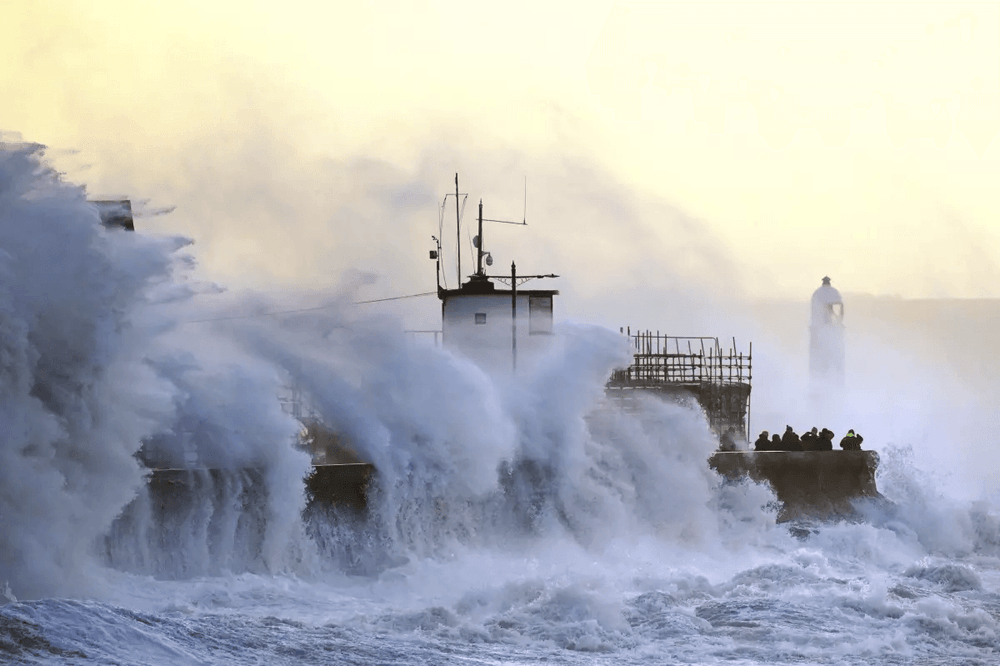Brace for the Gales: Why Europe Needs to Weatherproof Now!

The Brewing Storms Will Be the Most Furious
Europe has a long history with powerful storms, from coastal battering rams to inland tempests. These systems have shaped our landscapes, tested our resilience, and driven innovation in building and living. But climate change is throwing a wrench into this familiar pattern, with the potential for stronger, more disruptive windstorms in the future.
Extratropical cyclones, also known as windstorms, are already a major source of economic woes across Europe. These are large rotating weather systems that form in regions beyond 30 degrees latitude from the equator. They are characterized by low surface pressure, cold and warm fronts, and develop in regions with strong horizontal temperature gradients.
Europe experiences about 10 windstorms per month during the storm season, and a subset of these expansive, rotating weather systems have the potential to generate high winds, substantial rainfall, and even coastal storm surges, ultimately leading to extensive damage to infrastructure, disruptions to transportation and business operations, and adverse impacts on agriculture and forestry.
Recent storms like Ingunn, Jocelyn, and Gerrit are stark reminders of the disruptive power of windstorms. Powerful winds can topple trees, rip down power lines, and damage buildings, leaving communities in chaos. The true cost extends beyond immediate disruption.
Winter storms Eunice, Dudley, and Franklin in 2022 caused insured losses exceeding $4 billion – a significant increase from the previous decade's average (1). And history shows even larger events, like Storm Kyrill in 2007, are possible

The fury of Storm Eunice in 2022: Crashing waves pound Porthcawl, Wales.
(Jacob King / Associated Press).
How Windstorms Impact Businesses
- Infrastructure Damage: Power lines, buildings, and critical equipment like turbines and transformers are vulnerable, leading to costly repairs and production stoppages.
- Operational Disruptions: Outages and physical damage can disrupt business operations, causing delays in production, deliveries, and customer service. This can lead to lost revenue and dissatisfied customers.
- Supply Chain disruptions: Transportation networks can be impeded by blocked roads, canceled flights, and hindered port activities. This can delay delivery of raw materials and finished goods, impacting production schedules and inventory levels.
- Increased Operational Costs: Repairs and replacements after windstorms raise operational expenses. Additionally, potential disruptions to the energy grid may lead to higher energy prices.
- Safety Risks: Damaged buildings and infrastructure create safety hazards for employees and the public, adding to the overall cost burden.
- Reputational Damage: Businesses experiencing significant disruptions due to windstorms may face reputational harm, with customers opting for more reliable competitors.
The Future Looks Windy
The science is clear: climate change is likely to increase the intensity of windstorms across Northern and Central Europe (3). This translates to potentially double the storm severity based on what we are used to.
Expanding populations within these regions further exacerbate these risks. Even with the implementation of adaptation strategies, the overall risk level is anticipated to increase substantially.
Building Resilience in the Face of the Coming Storm
The good news is, we are not powerless. By proactively assessing and managing climate risks, we can build a more resilient Europe. Here at refinq, we are dedicated to helping businesses and communities prepare for the coming storm.
refinq’s Windstorm Risk Assessment for businesses
Our innovative climate risk assessment tool provides crucial insights into potential windstorm damage to your business infrastructure. We leverage the latest climate science to empower you to prepare for strong winds.
Key Features of our Windstorm Risk Assessment:
- Future-Proof Your Planning: Our assessment tool utilizes real-time wind data from nearby weather stations and incorporates the latest IPCC climate model projections for three warming scenarios to account for potential changes in wind patterns, ensuring your operations remain resilient in the face of a changing climate.
- Prioritize with Confidence: We translate complex wind data into clear, industry-standard risk scores. This empowers you to focus on areas most vulnerable to wind disruptions, optimizing your maintenance and investment strategies.
- Proactive Protection: By understanding your wind risk profile, you can proactively schedule maintenance or upgrades to critical infrastructure, minimizing downtime and costly repairs during storms.
- Supply Chain Continuity: Identify potential wind damage risks throughout your supply chain, safeguarding your production capacity and ensuring timely deliveries.
- Enhanced Grid Stability: Gain insights into wind risks across your entire infrastructure, enabling you to contribute to a more reliable and resilient energy grid.
Don't wait until the storm hits. Contact refinq today and take control of your wind risk.
By working together, we can navigate the changing winds and ensure a more secure future for Europe.
References:
- https://www.swissre.com/dam/jcr:1d793484-9b96-4e54-91c3-09f8fc841bde/2023-05-sigma-01-english.pdf
- https://www.latimes.com/world-nation/story/2022-02-18/2nd-major-storm-hits-northern-europe-causing-least-9-more-deaths
- https://www.nature.com/articles/s41467-023-40102-6
Cover Image: NOAA on Unsplash